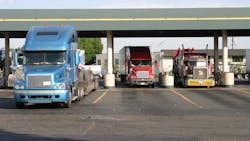If fleet managers are to focus their efforts on any one cost component, it must be fuel. It amazes me that today’s technology Class 8 tractors pulling full loads can achieve over 10 miles per gallon. Even more amazing is that the vast majority of fleets cannot even achieve 8 miles per gallon.
We are all singing the praises of battery-electric vehicles (BEVs) and the fact that they effectively achieve zero emissions. Fuel economy is not even in the conversation; it’s all about charging and charging infrastructure. BEVs and alternative-fuel vehicles are the future. But let’s face the facts: BEV technology for heavy-duty trucks (Class 8s) will not be able to replace the current long-haul diesel tractors for quite some time. So, if you are looking to bring BEVs into your fleet, you need to focus your efforts on Classes 1-6 vehicles. However, for long-haul applications we all need to focus on how to achieve the highest fuel economy possible.
See also: Truck OEM execs talk EV charging infrastructure pain points
The No. 1 factor that controls fuel economy in any vehicle is the driver. Reevaluating how we recruit, train, and compensate drivers—the most important aspect of our operations—will dramatically increase fuel economy and yield massive savings.
In a recent interview, I was asked about the driver shortage and how the industry could address the issue. The answer was simple: We need to lure the human resources needed from other industries by focusing on respect, benefits, and compensation. The pandemic presented a unique opportunity for the trucking industry, and we need to ride the wave of respect for truck drivers developed during those years, when the world realized that truck drivers are needed now more than ever.
Respect is something that is earned, and as part of any training program, fleets must focus on professionalism. Airline pilot training programs constantly drill processes, procedures, rules, and regulations. The amount of time and money invested in becoming a pilot is astronomical, and interestingly, the initial compensation package for a commercial airline pilot is equal to or less than that of a qualified truck driver. Even more interesting is that a truck driver will interact with far more people in a day of driving than an airline pilot will transport around the country.
We all owe a debt of gratitude to professional truck drivers, not only for delivering the goods we need every day, but for helping to keep us safe on the road. This mindset and level of respect is a recruiting tool. It will lure human resources away from other industries by showing new recruits how important it is to drive a truck.
Compensation and benefits are also keys to success. Here is where we can drive the behaviors that will increase safety and reduce fuel costs. Many jobs have performance-based compensation. If you want to achieve maximum fuel economy, you will need to compensate your drivers for success. A half-mile increase in fuel economy in a 75,000-mile-per-year application results in a savings of about $3,500 per tractor. Even if we paid the driver 20% of the savings as a performance bonus, we are still saving $2,800.
The numbers don’t look like needle movers on a per-truck basis, but if you have 100 trucks in the fleet, the savings add up quickly. The math on going from 7 to 10 mpg is a needle-mover for both the company and the driver.
How do you sustain this type of program? The answer is simple: The baseline is the fleet average and success above the fleet average is what should get rewarded.
Compensating drivers for helping you get more from each gallon of diesel—especially now that the cost of diesel is at an all-time high—is just smart business.
Patrick Gaskins, SVP of Corcentric Fleet Solutions, oversees both sales and operations for the company's fleet offerings. Gaskins joined the company in 2010, bringing more than 30 years of experience as a financial services professional in the transportation industry. He leads a team that works with a supply base of more than 160 manufacturers to help the country’s largest fleets manage all aspects of their fleet operations and fleet-related spend.
About the Author

Patrick Gaskins
Senior vice president, Fleet Solutions
Pat Gaskins is the senior vice president of Corcentric Fleet Solutions, where he leads both the sales and operations teams for the company’s fleet offerings. He has over 30 years of experience as a financial services professional in the transportation industry and manages partnerships with over 160 manufacturers, helping over 2,000 of the country’s largest fleets manage all aspects of their fleet operations and fleet-related spend.
